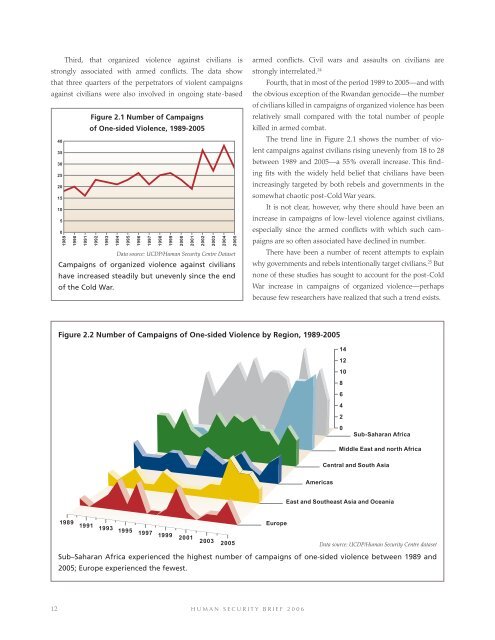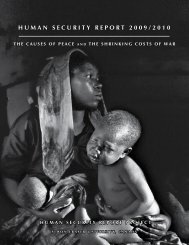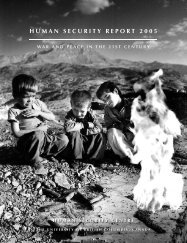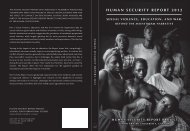Third, that organized violence against civilians isstrongly associated with armed conflicts. The data showthat three quarters of the perpetrators of violent campaignsagainst civilians were also involved in ongoing state-basedFigure 2.1 Number of Campaignsof One-sided Violence, 1989-2005403530252015105019891990199119921993199419951996199719981999200020012002200320042005Data source: UCDP/Human Security Centre DatasetCampaigns of organized violence against civilianshave increased steadily but unevenly since the endof the Cold War.armed conflicts. Civil wars and assaults on civilians arestrongly interrelated. 24Fourth, that in most of the period 1989 to 2005—and withthe obvious exception of the Rwandan genocide—the numberof civilians killed in campaigns of organized violence has beenrelatively small compared with the total number of peoplekilled in armed combat.The trend line in Figure 2.1 shows the number of violentcampaigns against civilians rising unevenly from 18 to 28between 1989 and 2005—a 55% overall increase. This findingfits with the widely held belief that civilians have beenincreasingly targeted by both rebels and governments in thesomewhat chaotic post-Cold War years.It is not clear, however, why there should have been anincrease in campaigns of low-level violence against civilians,especially since the armed conflicts with which such campaignsare so often associated have declined in number.There have been a number of recent attempts to explainwhy governments and rebels intentionally target civilians. 25 Butnone of these studies has sought to account for the post-ColdWar increase in campaigns of organized violence—perhapsbecause few researchers have realized that such a trend exists.Figure 2.2 Number of Campaigns of One-sided Violence by Region, 1989-200514121086420Sub-Saharan AfricaMiddle East and north AfricaCentral and South AsiaAmericasEast and Southeast Asia and Oceania1989 1991 1993 1995 1997 19992001Europe2003 2005Data source: UCDP/Human Security Centre datasetSub–Saharan Africa experienced the highest number of campaigns of one-sided violence between 1989 and2005; Europe experienced the fewest.12H U M A N S E C U R I T Y B R I E F 2 0 0 6
Figure 2.3 Number of Reported, Codable Deaths from One-sided Violence by Region, 1989-2005*RegionReported, codable deathsAfrica, sub-Saharan** 535,890Americas 8,187Asia, Central and South 13,903Asia, East and SE and Oceania 3,678Europe 14,811Middle East and north Africa 12,920Total 589,389Data source: UCDP/Human Security Centre DatasetEven without the huge death toll from the 1994 genocide in Rwanda (included in the above figure), sub-Saharan Africa has still suffered more deaths from one-sided violence than any other region.*Fatality figures are “best estimates.”**Uppsala’s “best” estimate for the death toll from the Rwandan genocide is 500,000, considerably lower than the more commonly cited figure of 800,000 which isalso Uppsala’s “high” estimate.Regional DifferencesSub-Saharan Africa endured 143 campaigns of deadly violenceagainst civilians between 1989 and 2005, more than any otherregion in the world. Fifty-three different actors (governmentsor non-state armed groups) perpetrated violent campaignsagainst civilians in 19 different countries.There were far fewer violent campaigns against civiliansin other regions in the period under review. Central and SouthAsia had 89 campaigns; the Middle East and north Africa 74;the Americas 44; East and Southeast Asia 38; and Europe 24,between 1989 and 2005.In addition to the high number of campaigns of onesidedviolence in sub-Saharan Africa, Figure 2.2 clearly showsthe sharp increase in violent campaigns against civilians in theMiddle East and north Africa that began in the new millennium.A large part of this increase has been associated with theupsurge of violence against civilians in Iraq and in Darfur. 26In East and Southeast Asia there was a marked increasein campaigns directed against civilians starting in 2001, butthere has been no consistent trend in Europe (which includesRussia), nor in the Americas.The difficulty UCDP researchers confront in establishingreliable estimates of death tolls from one-sided violenceis evident in the large variations between their “best” and“high” estimates of death tolls for some countries. In Darfur,for example, where obtaining reliable data is fraught withdifficulty, UCDP’s high estimate is eight times larger than itslow estimate.So the civilian fatality shown in Figure 2.3 shouldbe regarded with considerable caution—and seen as a veryrough guide to differences in the extent of killing betweenregions rather than a true reflection of different regional civiliandeath tolls.Knowing the civilian death tolls from one-sided violencefor each region over a 17-year period tells us little about trendswithin each region. In some cases there are no clear trends,but in sub–Saharan Africa there has been a steep, but veryuneven, decline in civilian deaths since the Rwandan genocidein 1994.In sub-Saharan Africa there has beena steep decline in civilian deathssince the Rwandan genocide in 1994.It is hard to overstate just how extreme and unusualan event the Rwandan genocide was. In just a few monthsmore than five times as many civilians were slaughtered in thisone country as in all other countries in the world from 1989 to2005. In fact the estimated death toll was almost as large as theglobal toll from all state-based conflicts in 1950, the deadliestyear for battle deaths in the entire post-World War II era.In the other regions, Europe had two sharp peaks in civiliandeath tolls—in the early and mid-1990s, with a muchsmaller peak in 1999. All were associated with conflicts in theH U M A N S E C U R I T Y B R I E F 2 0 0 6 13






